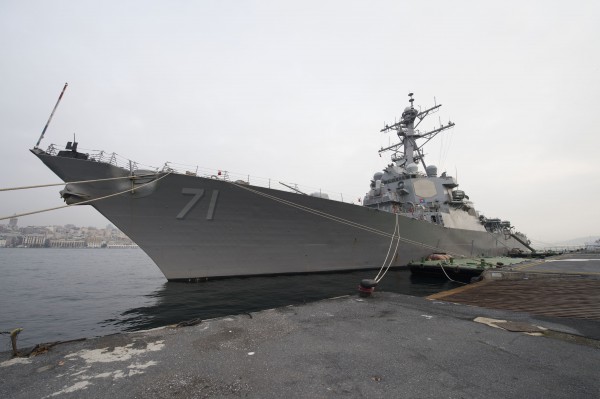
The top American officer in Europe wants two more destroyers stationed in his area of responsibility and a “better pace” of carrier strike groups and amphibious ready groups moving through the region, he said during a Tuesday hearing before the Senate Armed Services Committee.
Army Gen. Curtis Scaparrotti said the two destroyers would supplement the four already forward stationed in Rota, Spain. The increased presence of large warships would send a message to allies and to Moscow that NATO is able to deter and counter “an evolving and modernizing Russian fleet.”
“We’ve got to modernize. … We do need greater capacity” in the depth of NATO’s land forces, intelligence, surveillance and reconnaissance (ISR) and naval forces to address the Kremlin’s new challenges, he said.
In follow-up questions on overall modernization, Scaparrotti said on nuclear forces, “I would note [the Russians] have a triad as well.” He also cited the need for the alliance to maintain its dominance of the undersea domain.
In what is likely his final appearance before the panel, he told senators, “I’m not comfortable yet” with NATO’s posture in providing “credible deterrence” to Russia. Scaparrotti said he would go into greater detail during the committee’s closed session in the afternoon as to how he would close the gaps.
Since NATO expanded to the east, logistics challenges have been magnified, he said. Defending these new members means not only added distances, but having to deal with different gauges of railroads, conditions of airfields, the operation of pipelines and use of highways for military transport of heavy vehicles.

Scaparrotti said the European Union has put $7 billion toward eliminating those challenges over the next five to six years. “We have to make sure [the money] goes to the right places to make a difference,” he said.
Physical infrastructure and movement of equipment and personnel are a visible need, but the alliance also is facing a far more aggressive information warfare effort and cyber harassment.
The New York Times reported Gen. Valery Gerasimov, the chief of staff of the Russian armed forces, late last week again endorsed “hybrid warfare” as a Kremlin tactic and part of its strategy to keep adversaries like NATO off-balance, in a story cited by several senators Tuesday.
The Russians “have a good deal of agility and seemingly no restraints on what they can say” in disinformation campaigns to undermine trust in Western governments and meddle in elections, Scaparrotti said. The Baltic nations, which have most often been subjected to these tactics as well as cyber attacks on their communications and power systems, have pointed the way for NATO in blunting the Kremlin’s disinformation efforts and countering cyber disruptions of vital infrastructure. The alliance’s cyber defense center is headquartered in Estonia, and Scaparrotti said member nations are adding cyber capabilities to their security planning and operations.

“Russia is very good” at cyber operations, he repeated several times in answering different senators’ questions.
When the subject turned to Turkey’s role in the alliance, Scaparrotti said the military-to-military relationship remain strong. But he said if Ankara goes ahead and buys a sophisticated Russian air defense system, “my best military advice would be we don’t follow through with the [sale of] the F-35.”
He pointed out that the Russian S-400 system is not interoperable with existing NATO air defense systems in its missile defense systems. Adding to the security risk, it would also give the Kremlin an opportunity to learn more about the F-35 Lightning II Joint Strike Fighter through their work with the Turks.
Turkish aircrews are already in training in the United States for the fifth-generation fighter, and Turkish industry has been involved in the production of the aircraft’s fuselage and cockpit. If the sale is blocked, Ankara would also be cut out of the aircraft’s industrial base.
Scaparrotti’s warning to Ankara is not a new caution from the United States. Vice President Mike Pence made the same point at the recent Munich security conference. Last summer, Lockheed-Martin, the prime contractor, said the cost of individual aircraft would not rise significantly if Turkey was dropped as a buyer.
“I would hope they would reconsider this decision on the S-400, one system, but potentially forfeit many of the other systems and one of the most important systems we provide them,” Scaparrotti said.





